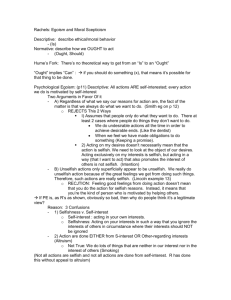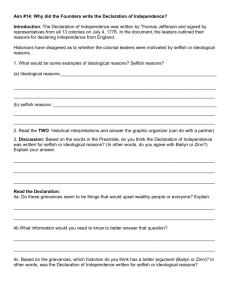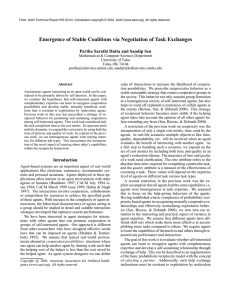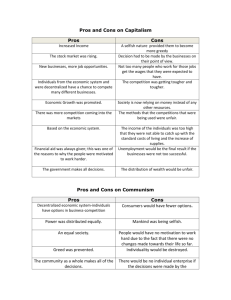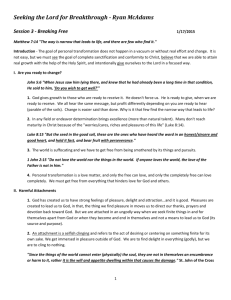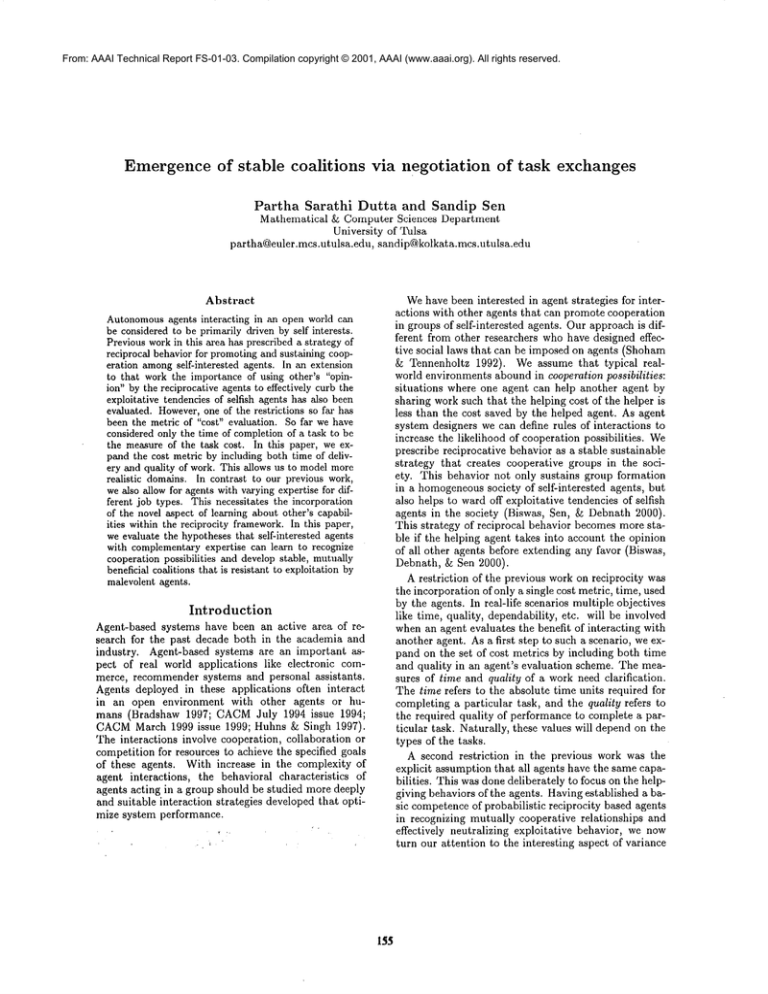
From: AAAI Technical Report FS-01-03. Compilation copyright © 2001, AAAI (www.aaai.org). All rights reserved.
Emergence of stable coalitions
via negotiation
of task exchanges
Partha
Sarathi
Dutta
and Sandip
Sen
Mathematical &5 Computer Sciences Department
University of Tulsa
par tha@euler.mcs.utulsa.edu, sandipQkolkat a.mcs.utulsa.edu
Abstract
Autonomousagents interacting in an open world can
be consideredto be primarily driven by self interests.
Previous workin this area has prescribed a strategy of
reciprocal behavior for promotingand sustaining cooperation amongself-interested agents. In an extension
to that work the importance of using other’s "opinion" by the reciprocative agents to effectively curb the
exploitative tendencies of selfish agents has also been
evaluated. However,one of the restrictions so far has
been the metric of "cost" evaluation. So far we have
considered only the time of completionof a task to be
the measure of the task cost. In this paper, we expand the cost metric by including both time of delivery and quality of work. This allows us to modelmore
realistic domains. In contrast to our previous work,
we also allow for agents with varying expertise for different job types. This necessitates the incorporation
of the novel aspect of learning about other’s capabilities within the reciprocity framework.In this paper,
we evaluate the hypothesesthat self-interested agents
with complementaryexpertise can learn to recognize
cooperation possibilities and develop stable, mutually
beneficial coalitions that is resistant to exploitation by
malevolentagents.
Introduction
Agent-based systems have been an active area of research for the past decade both in the academia and
industry. Agent-based systems are an important aspect of real world applications like electronic commerce, recommender systems and personal assistants.
Agents deployed in these applications often interact
in an open environment with other agents or humans (Bradshaw 1997; CACM
July 1994 issue 1994;
CACM
March 1999 issue 1999; Huhns ~ Singh 1997).
The interactions involve cooperation, collaboration or
competition for resources to achieve the specified goals
of these agents. With increase in the complexity of
agent interactions, the behavioral characteristics
of
agents acting in a group should be studied more deeply
and suitable interaction strategies developed that optimize system performance.
Wehave been interested in agent strategies for interactions with other agents that can promote cooperation
in groups of self-interested agents. Our approach is different from other researchers who have designed effective social laws that can be imposed on agents (Shoham
& Tennenholtz 1992). We assume that typical realworld environments abound in cooperation possibilities:
situations where one agent can help another agent by
sharing work such that the helping cost of the helper is
less than the cost saved by the helped agent. As agent
system designers we can define rules of interactions to
increase the likelihood of cooperation possibilities. We
prescribe reciprocative behavior as a stable sustainable
strategy that creates cooperative groups in the society. This behavior not only sustains group formation
in a homogeneoussociety of self-interested agents, but
also helps to ward off exploitative tendencies of selfish
agents in the society (Biswas, Sen, ~: Debnath 2000).
This strategy of reciprocal behavior becomes more stable if the helping agent takes into account the opinion
of all other agents before extending any favor (Biswas,
Debnath, ~5 Sen 2000).
A restriction of the previous work on reciprocity was
the incorporation of only a single cost metric, time, used
by the agents. In real-life scenarios multiple objectives
like time, quality, dependability, etc. will be involved
when an agent evaluates the benefit of interacting with
another agent. As a first step to such a scenario, we expand on the set of cost metrics by including both time
and quality in an agent’s evaluation scheme. The measures of time and quality of a work need clarification.
The time refers to the absolute time units required for
completing a particular task, and the quality refers to
the required quality of performance to complete a particular task. Naturally, these values will depend on the
types of the tasks.
A second restriction
in the previous work was the
explicit assumption that all agents have the same capabilities. This was done deliberately to focus on the helpgiving behaviors of the agents. Havingestablished a basic competenceof probabilistic reciprocity based agents
in recognizing mutually cooperative relationships and
effectively neutralizing exploitative behavior, we now
turn our attention to the interesting aspect of variance
155
in agent expertise. Weassume that different agents
have different skill sets which makethem more effective
in accomplishing some tasks versus others. Werequire
agents to learn the capabilities of themselves and others
through performance and interaction.
The goal of this work is to evaluate whether selfinterested agents can learn to recognize agents with
complementary expertise and develop a self-sustaining
relationship through exchange of help. This can be described as an augmentation of the basic probabilistic
reciprocity model with the concept of selecting a partner. Additionally, such help exchange inclinations must
be resistant to exploitation by malevolent agents who
do not reciprocate help-giving actions. Our hypothesis is that when combined with an appropriate learning
scheme, probabilistic reciprocity based strategies will
enable the development of stable, mutually beneficial
coalitions of self-interested agents with complementary
skill sets.
i to do task j is given by
Vr(i, k, j, l)
1
c~i+ov-~.c~vg-sk, ’
T
1 + exp
where Ck~g is the average cost of tasks performed by
agent k; Bki is the net balance that agent k has with
i, due to the previous helps given to and received from
agent i; OPis the balance that agent i has with other
agents excluding agent k; Ck is the cost of agent k to do
the task j of agent i;/3 and r are constants where ;3 is
used to set the cost an agent is ready to incur to help an
unknownagent with the hope of initiating a long-term
cooperative relationship and r is used to the shape of
the probability curve. This is a sigmoidal probability
function where the probability of helping increases as
the balance increases and is more for less costly tasks.
Weinclude the C~.g term because while calculating the
probability of helping, relative cost should be more important than absolute cost.
In this paper we aim at extending the basic probabilistic reciprocity framework. Weevaluate the importance of "quality of performance" as another cost
metric and the applicability of learning other agents’
capabilities in developing stable, cooperative coalitions
amongself-interested agents.
Reciprocity
Altruistic behavior has been the topic of research for
mathematical biologists and economists. The objective
of such research has been to verify the rationality of
adopting such behavior, to analyze the success of altruistic individuals in an environmentof self-interested
agents and to study the evolution of genetic patterns
supporting such behavior among communities (Badhwar 1993; de Vos & Zeggelink 1994; Goranson &
Berkowitz 1966; Krebs 1970; Macy & Skvoretz 1998;
Schmitz 1993; Trivets 1972). The concept of reciprocal
altruism has been evaluated to explain the emergenceof
stable cooperative groups amonga society of interacting agents (Zeggelink, de Vos, & Elsas 2000). Majority
work in the field of gametheory have evolved around the
idealized problem called Prisoner’s dilemma (Rapoport
1989). Robert Axelrod has shown using a simple deterministic reciprocal strategy how stable cooperative
behavior can be achieved in self-interested agents (Axelrod 1984).
Even though tit-for-tat
strategy explains the stability of reciprocal behavior in the repeated Prisoner’s
dilemma tournament framework, the applicability
of
this analysis in more realistic multiagent environments
is limited by unrealistic assumptions like symmetrical
interactions, repetition of identical scenarios, lack of a
measure of work, etc. Hence, such naive schemes cannot be used as a robust solution approach for encouraging the emergence of stable, mutually cooperative,
groups in a real-life, open agent society. Wehave proposed a probabilistic reciprocative approach where the
probability of extending help to another agent depend
on the interaction history with that agent (Sen 1996).
Our probability-based reciprocal behavior is designed
to enable an agent make decisions about agreeing to
or refusing a request for help from another agent. The
probability that agent k, having task l, will help agent
Problem
domain
Weevaluate our hypothesis using simulations in a job
completion problem domain. In this domain each of N
agents are each assigned T jobs. There are K job types
and each agent has expertise in one of these K job types.
An agent who is an "expert" in a particular job type
can do the job in less time and with higher quality than
other job types. The jobs can be finished at any one
of F different machines. Agents are assigned their jobs
when the simulation starts. At this point every agent
asks for help from some selected candidates amongall
other agents. Initially the probability of selecting an
agent for asking help is the same for all agents. This
is because the asking agent has no prior model of the
other agents’ behaviors. However, as agents learn over
interactions, some agents becomemore likely to be selected by an agent when the latter is seeking help. The
simulation ends when every agent has finished all of
their assigned jobs.
Selecting
partners
Wehave incorporated the concept of agents learning to
select another agent for asking help. Agents have estimates of their own abilities to do the different job
types. Estimates are of two types: time estimate,
whichreflects the possible time of completion of the job,
and quality estimate, which reflects the possible performancelevel of an agent to do that job. Agents also keep
estimates of other agents’ abilities. Agentestimates are
initialized to zero. To obtain estimates about their own
abilities, agents must themselvesfinish a job of a certain
type if it has never encountered another job of that type
156
before. Every job requires a certain time and quality of
performance to be finished. These task-specific values
are used by the agents to measure their performance.
Estimates about another agent are updated using the
time and quality of performance values that the other
agent requires to complete the particular type of job.
These estimates are used by the agents to compute
the cost of a particular task delivery. Whenasking for
help, agents computethe cost C1, incurred by itself to
do that task. The estimated cost C2 of the prospective
helping agent for that work is also computed. Help
is obtained only if C2 < C1. One important issue in
determining the estimated cost C2 is that, if the task
type of the asking agent’s present task is different from
that of the task the helping agent is executing, then
an additional cost factor is added to C2. This takes
into account the cost incurred by the helping agent to
change the setup of a machine for a new kind of job.
Oncean agent does a particular task of a certain type,
it updates its self-estimate about that task type. If an
agent is helped by another agent, it updates its estimate
of the helping agent’s ability to do that task type. This
ensures a reinforcement learning of one’s own abilities
and those of others for every job type. Given sufficient
interaction possibilities betweenagents, they learn the
behavioral characteristics of other agents. This information is used to select an agent for asking help. Naturally, as a consequenceof learning others’ abilities, an
agent i whospecializes in job type T1, whengiven a job
of type :/h, will decide in favor of asking help from an
agent j specializing in job type T2, rather than agents
whospecialize in other job types. Thus, given sufficient
interaction possibilities, agent coalitions develop where
self-interested agents have complementaryskill sets.
any circumstances. This basic premise holds in our selfish agents too. However, they are characterized by the
additional property of lying when they are approached
for opinion by a reciprocative agent. They lie about
the balance they hold at any time with the agent who
is currently waiting to receive help. Moreformally, if
the agent asking help is A, that deciding whether to
help or not is B and asking a selfish C for opinion, then
C says "A has a positive balance of X units with me",
where X is actually the positive balance that C has
with A, because A helped C on previous interactions.
Thus the selfish agents add more damage, and we call
such agents as individual lying selfish agents.
Experimental
results
In the first set of experiments we monitored the average
savings obtained by the reciprocative agents. Savings
earned by an agent is the cost it saves by giving up
the job to another agent. Higher the savings, better
is the agent performance and vice versa. Savings can
be a rneasure of time or resource saved by giving up
a job to another agent. Our results show that with
the increase in the number of per-agent tasks, the average savings of reciprocative agents increase, given the
same percentage distribution of selfish and reciprocative agents in the population. However, given the same
value of per-agent task level, the average savings of reciprocative agents decrease as the percentage of selfish
agents increases in the population (see Figure 1). Increase in average savings with the increase in per-agent
jobs is due to more interactions between reciprocative
agents that allowed them to identify helpful agents with
complementary expertise. The above experiments were
conducted by varying the selfish percentage in the population from 50 to 80 in steps of 10. For each such
setting, the per-agent task was varied from 20 to 100 in
steps of 20.
In the second set of experiments we studied the variations in average savings earned by both selfish and
reciprocative agents after each agent had completed all
of its jobs. Figures 2 and 3 show the results obtained
by varying the percentage of selfish agents in the population under two different values of "tasks per agent",
20 and 40 respectively. The percentage of selfish agents
in the population was varied from 50 to 80%in steps of
10%. In both the figures we find reciprocative agents
outperform selfish agents, because the average savings
earned by the reciprocative agents are more than those
of the selfish agents for all selfish percentages in the
population. In both cases the savings earned by reciprocatives decrease with increase in the percentage of
selfish population. For the same percentage of selfish
population, however, the savings earned by the reciprocatives are higher whenthe per-agent tasks are higher
(40 in this case). Fromthese observations, we can conclude that, reciprocative agents learn to select partners
and this enables them to enter into mutually beneficial
coalitions. Savings earned, which reflects how good the
behavior of the agent has been during its interactions
Agent types
The behavior of reciprocative agents is determined by
the level of available information to the agents about
other agents. Wementioned that agent A will receive
help from agent B only if the cost incurred by A to
do that task is more than incurred by B for helping A.
However, in deciding whether to help or not to help,
the reciprocative agents can ask some other agents for
their opinion about the agent asking help. The agents
from whoma help-giving agent asks for opinion are only
those with whomit has a favorable balance, that is,
from those it has received more help than given away.
This is a reasonable policy, to believe in those whohave
earned trust by their interactions. The opinion received
by the helping agent is the cumulative balance that the
agent (who is seeking help) has with the agents from
whomopinion is obtained. This reduces if the helpseeking agent has received more help than given away
to those giving opinion, and vice versa. An agent who
has a "good" record of help giving behavior is more
likely to be helped, l~eciprocative agents who decide
to help or not based on such collaborative opinion are
called earned trust based reciprocative agents.
Selfish agents by definition do not extend help under
157
Averagesavings eanmdby reciprocative agents
Average
savingsearned
by selfishandrnciprocative
agents
90
110
50%selfish
60%selfish -~--70%selfish -G---~
80
Tasksperagent= 20
I00 5,
70
90
60
80
50
70
""""’,,
40
60
/
¯ .."
<
Reciprceative
30
50
j, ,¯’" ..×,,7
d"...’" .............
,,’*..N"............
20
40
10
Selfish
,,
30
0
20
I
30
I
40
I
I
I
50
60
70
Tasksper agent
I
80
I
90
20
100
50
Figure 1: Variation of average savings with per-agent
task.
"
I
55
I
60
I
i
65
70
Selfishpercentage
I
75
80
Figure 2: Average savings of agents with 20 tasks per
agent.
with other agents (more a reciprocative agent helps another reciprocative agent, moreis the probability that
it will receive help fromthe one it helped), is therefore,
higher in reciprocatives than selfish agents. Lowervalues of savings earned by the selfish agents indicate that
the reciprocative agents have effectively shunnedthe exploitative selfish agents. Theeffectiveness, however,decreases with increase in the number
of the selfish agents.
This is due to the lesser probability of interaction with
another reciprocative agent, than with another selfish
agent. With increase in the task level, however, the
savings of reciprocative agents for the same numberof
selfishes in the population are more because a higher
numberof per agent tasks makes it necessary for the
agents to stay "on the field" for a longer time. This has
a similar effect to what we obtained with a higher number of reciprocative agents comparedto a lower value
- the average savings earned by the reciprocatives are
more.
In the final set of experiments, we studied the nature
of coalitions developing amongreciprocative agents. In
the current context, viable coalition formation depends
both on identifying potentially beneficial partnerships
and then nurturing them through mutually beneficial
exchanges of help. The complementarityof expertise is
a useful indicator of the potential of a mutuallybeneficial partnership. Wemonitor the developmentof agent
groups whereall agents are inclined to help each other.
Our results show that groups of agents with complementaryexpertise have larger sizes. These experiments
were run using 100 tasks per agent and an equal distribution of selfish and reciprocative agents in the population.
Agents are differentiated on the basis of the types of
158
Groups
Group Size
1,1
20
2,2
28
3,3
12
1,2
60
1,3
38
2,3
47
Table 1: Size of stable coalition betweendifferent agent
types.
job they are most proficient in. Groups are defined as
coalitions of agents of such differing expertise. To determine a group, say between reeiprocative agents who
are proficient in job-types T1 and T2, we computethe
numberof agents specializing in job-type T2 whohave
helped an agent specializing in type T1. This is calculated for all agents specializing in type T1. This calculation is again computedwith the roles (helper and
helped) of agent types T1 and T2 reversed. The sum
of the two results gives the group size of agents with
expertise in types T1 and 772. The values of such group
sizes are given in Table 1. The numberswithin braces
are the job-types in whichagents have expertise. Thus,
group{x, y} is the groupof agents whospecialize in job
types x and y.
Theseresults showthat the savings of groupsof reciprocative agents with complementary
expertise are larger
than groups of agents with similar expertise. These results indicate that reciprocative agents tend to form
stable and beneficial groups with other reciprocative
agents who have complementaryexpertise.
Oursimulations have shown that in a heterogeneous
groupof agents with varying expertise for different job
types, reciprocative agents can learn to detect agents
with complementaryexpertise and form mutually beneficial and stable groups¯ An extension of this workcan
be the inclusion of dynamically changing behavior of
40O
Average
savingsearnedbyselfish andreeiprocativeagents
350 ""..,,,,.[..,,..
’
However, in an attempt to learn behaviors of all other
agents, our approach can become time consuming in
situations where number of agents increase exponentially. A concept of using "congregations" to determine
"who" to interact with in an agent society is addressed
in (Brooks, Durfee, & Armstrong 2000). However, determining the right congregation again suffers from the
time issue when number of agents increase exponentially. Besides, congregations are not true coalitions.
Tasks per agent = 40 ’
".., Reciprocative
30O
250
20O
Conclusions
and future
directions
Adoption of reciprocal behavior in a society of selfinterested agents generates incentives that promote cooperative behavior. In this paper we hypothesized that
in an agent society agents differ in their expertise, incorporation of a learning component will help generate cooperative groups of agents with complementary
expertise. Our simulations confirmed this hypotheses.
These groups are mutually beneficial to the agents because they save more time and get their jobs finished
with better quality of performance by giving it to another agent who has the required expertise. Such cooperative group formation is stable since the exploitative
agents get shunned effectively.
We are still running further set of experiments and
plan to present a more extensive set of results detailing
the gain in quality, completion time, etc. for groups
with complementary expertise.
One assumption in this work has been that agents
have fixed behaviors. A more realistic scenario would
be for an agent to have the freedom of changing its behavior when it deems appropriate. Such behavior adoption leads to an evolutionary process with a dynamically changing composition of agent group behaviors.
Weplan to investigate whether such evolving agent behavior might create a society of agents with the same
behavior, which could be the optimal behavior to adopt.
150
10O
50
Selfish
0
50
I
55
i
60
o
I
I
65
70
Selfishpercenlage
i
75
Figure 3: Average savings of agents with 40 tasks per
agent.
agents, that might evolve one of the strategies
stable strategy.
as the
Related
work
Using agent coalitions is an interesting and muchcultivated methodology to solve complex, distributed tasks.
Assigning groups of agents to do a task or multiple tasks
has the advantage of individual agent expertise being
used to complete a part of the global problem.
However, work in the area of coalition formation in
agent societies has focussed on cooperative agents (Shehory & Kraus 1998). A related work on coalitions
in agent societies takes self-interested agents into account (Lerman & Shehory 2000). But it does not consider the possible heterogeneity in performanceof a task
between different agents. Our work is different from
these because it takes into consideration self-interested
agents that have different performance levels for different task types. Wealso have a learning parameter
in our agents which is used to identify other’s qualities. This, in turn, favors those with complementary
expertise when asking for help. Mutual understanding
of capabilities evolve cooperative groups in the society
of self-interested agents. Learning of cooperative behavior has also been addressed in (Denzinger & Krodt
2000). However,there the online learning uses an a priori off-line learning modulewhich generates situationaction pairs using GA.To determine the fitness of the
evolved situation-action pairs during off-line learning
an agent-model is required. This is obtained by observing other’s behavior, which implies learning once
more, or the model can be stored in an agent’s data
area. Our work uses only online learning and agents
do not have to store a priori models of other agents.
Acknowledgments This work has been supported
part by an NSF CAREERaward IIS-9702672.
in
References
Axelrod, R. 1984. The Evolution of Cooperation. Basic
Books.
Badhwar, N. 1993. Altruism versus self-interest:
sometimes a false dichotomy. Social Philosophy ~ Policy
10(1):90-117.
Biswas, A.; Debnath, S.; and Sen, S. 2000. Believing
others: Pros and cons. In Proceedings of the Fourth
International Conference on Multiagent Systems, 279285.
Biswas, A.; Sen, S.; and Debnath, S. 2000. Limiting
deception in groups of social agents. Applied Artificial
Intelligence (Special Issue on Deception, Fraud, and
Trust in Agent Societies) 14(8):785-797.
Bradshaw, J. M. 1997. Software Agents. Menlo Park,
CA: AAAI Press/The MIT Press.
159
Brooks, C.; Durfee, E.; and Armstrong, A. 2000. An
introduction to congregating in multi-agent systems.
In Proceedings of the ~burth International Conference
on Multi-Agent Systems, 79 86.
segmentation of reciprocal altruists who prefer ’oldhelping-partners’. Journal of Artificial Societies and
Social Simulation 3(3):212 15.
1994. Communications of the ACM,july 1994, volume
37, number7. Special Issue on Intelligent Agents.
1999. Communications of the ACM,march 1999, volume 42, number 3. Special Issue on Multiagent Systems on the Net and Agents in E-commerce.
de Vos, H., and Zeggelink, E. 1994. The emergence
of reciprocal altruism and group-living: an objectoriented simulation model of humansocial evolution.
Social Science Information 33(3):493-517.
Denzinger, J., and Krodt, M. 2000. Evolutionary online learning of cooperative behavior with situation action pairs. In Proceedigns of the Fourth International
Conference on Multi-Agent Systems, 103-110.
Goranson, R., and Berkowitz, L. 1966. Reciprocity
and responsibility reactions to prior help. Journal of
Personality and Soial Psychology 3(2):227-232.
Huhns, M. N., and Singh, M. P. 1997. Readings in
Agents. San Francisco, CA: Morgan Kaufmann.
Krebs, D. 1970. Altruism an examination of the
concept and a review of the literature. Psychological
Bulletin 73(4):258-302.
Lerman, K., and Shehory, O. 2000. Coalition formation for large-scale electronic markets. In Proceedings
of the Pburth International Conference on Multi-Agent
Systems, 167-174.
Macy, M. W., and Skvoretz, J. 1998. The evolution
of trust and cooperation between strangers: a computational model. American Sociological Review 63:638660.
Rapoport, A. 1989. Prisoner’s dilemma. In Eatwell, J.;
Milgate, M.; and Newman,P., eds., The NewPalgrave:
GameTheory. London: Macmillan. 199--204.
Schmitz, D. 1993. Reasons for altruism. Social Philosophy Cfl Policy 10(1):52 68.
Sen, S. 1996. Reciprocity: a foundational principle for
promoting cooperative behavior among self-interested
agents. In Proceedings of the Second International
Conference on Multiagent Systems, 315 321. Menlo
Park, CA: AAAIPress.
Shehory, O., and Kraus, S. 1998. Methods for task
allocation via agent coalition formation. Artificial Intelligence 101 (1-2) :165-200.
Shoham, Y., and Tennenholtz, M. 1992. On the synthesis of useful social laws for artificial agent societies
(preliminary report). In Proceedings of the National
Conference on Artificial Intelligence, 276-281.
Trivets, R. 1972. The evolution of reciprocal altruism.
Quarterly Review of Biology 46:35-57.
Zeggelink, E. P.; de Vos~H.; and Elsas, D. 2000. Reciprocal altruism and group formation: The degree of
160

